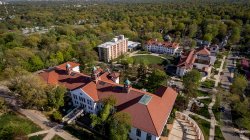The University’s branded student experience will provide all students with well-resourced educational, co-curricular, and student life experiences that transform their concepts of individual potential and prepare them successfully to engage and excel in careers that benefit and contribute to society; that are fully aligned with their personal goals and talents; that develop professional expertise and the capacity for life-long learning and that establish lifelong connections with their peers, the community and the University. The University will be intentional in supporting the engagement of all students in demonstrated high-impact teaching and learning practices and robust co-curricular programming.
Objective 1.1
Create and sustain high quality, rigorous, and competitive academic programs that serve student needs and continue to elevate the institution’s reputation.
Strategies
a) By 2025, refine the undergraduate and graduate academic portfolio to include new programs that emphasize professional competence and leadership skills in growth areas in the region, including STEM fields, health, media, and management
b) Redesign the liberal arts core curriculum with renewed dedication to ensuring competencies in digital technologies; media literacy; analytical reading; skillful writing; oral communication; critical thinking; historical consciousness; and civic and ethical awareness, anchoring these competencies in best assessment practices
c) Adopt the use of personal graduation portfolios that students will curate from their first day of classes, as a repository and record of all their academic and co-curricular activities over the course of their education
d) Expand the development of effective student-focused transfer programs with community colleges
e) Create innovative, flexible and mediated teaching and study spaces that will enable teacher experimentation with and use of new technologies and pedagogical techniques, fostering increased student engagement, collaboration and active learning both during and outside of classroom hours
f) Develop degree completion programs, online programs, and alternative scheduling of programs and courses to support student access and success
Success Measures
1.1.1. Increased relevance, demand for, and academic quality of undergraduate and graduate programs leading to a degree or certificate from the baseline in AY2019-20
1.1.2. Increased student performance levels on the Collegiate Learning Assessment Plus (CLA+) instrument, both in terms of the percent of students who meet basic competencies, as well as in terms of the relative performance of MSU students versus students from peer institutions
1.1.3. Increased percent of freshmen and seniors who describe the rigor of their courses at MSU as “Very High” or “High” on the National Survey of Student Engagement (NSSE) instrument
1.1.4. Improved University standing, and the standing of its academic programs, as determined in select national rankings, from baselines in AY2019-20
1.1.5. Increased number of online programs leading to a degree or certificate from the baseline of AY2019-20
1.1.6. Increased delivery of programs in fully online mode by 100% over the baseline of programs in 2019-20
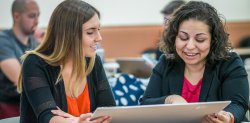
Objective 1.2
Increase engaged student participation in an expanded range and variety of campus experiences and support activities.
Strategies
a) Promote maximum access to internship opportunities and cooperative educational experiences for all students
b) Enhance superior academic performance through expansion of Honors options and societies within majors, and support for applications to premier post-secondary opportunities such as Fulbright, Gates-Cambridge, Gilman, Marshall, Mitchell, Rhodes, Schwarzman and Truman scholarships
c) Increase communication and participation in activities and programs focused on increasing the well-being of students to support the development of the whole student
d) Achieve national stature as a top NCAA Division III institution
e) Promote and support student engagement with professional societies, social clubs and interest groups that evolve as the student body evolves
Success Measures
1.2.1. Increased levels of engagement across a range of campus experiences as measured by student-reported activity and satisfaction on national surveys (i.e. The Freshman Survey, the College Senior Survey, the Ruffalo Noel-Levitz Student Satisfaction Index, and the National Survey of Student Engagement)
1.2.2. Increased levels of engagement across a range of campus experiences as measured by recorded memberships, attendance at academic events, and other measures of participation
1.2.3. Expanded range of student organizations and events, and increased participation rates
1.2.4. Increased student use of academic and other support services and facilities over baselines established in AY2019-20
1.2.5. Increased conference championships and participation in Division III NCAA playoffs, increased attendance at athletic events, and robust success in the recruitment of student athletes
1.2.6. Increased degree completion rates and higher academic achievement of student athletes over baselines established in AY2019-20
1.2.7. Increased student success in winning competitive post-graduate scholarships and fellowships
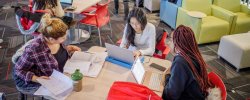
Objective 1.3
Identify and craft signature transformative student experiences that contribute to a distinct identity for the university across both curricular and co-curricular programming.
Strategies
a) Provide curricular and co-curricular programming to prepare graduates for the world of work and lay a foundation for the continued acquisition of knowledge and skills that assure competence in an evolving work environment
b) Assure curricular and co-curricular experiences that require teamwork, leadership, problem solving and decision making, cultural competence, and creative thinking
c) Leverage the range of cultural experiences offered by the university to engage students in activities that enhance learning through the arts, athletics, and programming available to all community members
d) Enhance student experience through career development activities that link both curricular and co-curricular programming to alumni and post-graduate success
e) Enhance the development of badging opportunities to promote skill development, curricular and co-curricular opportunities, and skills important for life after Montclair
f) Increase high impact experiences by expanding access to and participation in national and international programs that broaden understanding of the nation in the world
Success Measures
1.3.1. Measure those activities and experiences assessed by the CLA+, the National Survey of Student Engagement, or the Higher Education Research Institute that yield the greatest gain scores, or value-added, from entry to graduation for Montclair State University students
1.3.2. Increased number of new programs and experiences that, based upon analysis of existing, highly transformative programs, appear to have the most potential to transform students academically or personally
1.3.3. Realized acquisition of international Fulbright awards by students
1.3.4. Increased student participation in UN Academic Impact programs and in the Higher Education Sustainability Initiative (HESI)
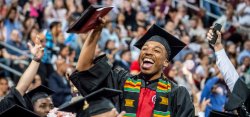
Objective 1.4
Leverage new services and technologies to ensure timely completion of degrees.
Strategies
a) Assure intentional degree program design in every program to enable timely completion to degree for all students
b) Develop robust university analytics for monitoring and promoting student and alumni success, including EAB Navigate, First Destination Survey, and other platforms
c) Establish a senior level Enrollment Management Group that uses data to research and manage multiyear enrollment, retention and graduation goals that are supported by the institution
Success Measures
1.4.1. Increase first-semester retention to 95%, and sustain that level of success once achieved
1.4.2. Increase first-year retention to 85%, and sustain that level of success once achieved
1.4.3. Increase four-year graduation rates to 60%, and sustain that level of success once achieved.
1.4.4. Increase the six-year graduation rate to 80% and increase that level of success once achieved

Objective 1.5
Expand programs and services that improve students’ opportunities for life-long success and engaged citizenship, and increase the University’s commitment to their continued relationship
as alumni.
Strategies
a) Create advanced on-line portals and self-service functions to support the availability of essential student and alumni resources – Red Hawk Central, Academic Advisement, Career Services, Technical Support Services
b) Develop University-wide career counseling protocols to guide all students toward successful post-graduation careers, leveraging relationships with alumni, their employers and other external partners
c) Develop a reliable tracking system for post-graduate success in careers and subsequent degree attainment
d) Create mechanisms to better connect students and alumni for mutually beneficial activities
e) Strengthen alumni relations activities with coordinated efforts across the university
Success Measures
1.5.1. Increased number and percent of students who participate in experiential learning activities including co-ops, internships, clinical practice, study abroad and other programs that include a significant real-world component
1.5.2. Increased number and percent of students who visit Career Services for career counseling or self-assessments, or who take advantage of job fairs and other employment-related activities
1.5.3. Increased training opportunities, courses, and other non-credit services for professional and career development offered by Colleges and Schools
1.5.4. Increased number of Montclair State University alumni participating in courses or activities sponsored by College or School continuing education programs
1.5.5. Increased number and percent of Bachelor’s degree recipients who further their education by enrolling in accredited graduate programs
1.5.6. Increased number and percent of Bachelor’s degree recipients who earn Master’s and/or Doctoral degrees
1.5.7. Increased number and percent of students who volunteer to participate in activities sponsored by the Center for Community Engagement
1.5.8. Increased number and percent of students who vote
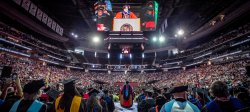
Objective 1.6
Increase awareness of the University’s identity and impact, and enhance its reputation.
Strategies
a) Craft a clear and authentic brand narrative for the University, convey this narrative consistently and effectively to all key audiences using a strategic mix of paid advertising, earned news coverage, owned channels and social networking
Success Measures
1.6.1. Improvements in name recognition, brand awareness, and favorable perceptions by key audiences, as measured by survey research
1.6.2. Growth in news coverage of key brand drivers (e.g. faculty research and expertise, student accomplishments, and institutional impact on the state/nation/world) and improvements in channel-specific metrics
